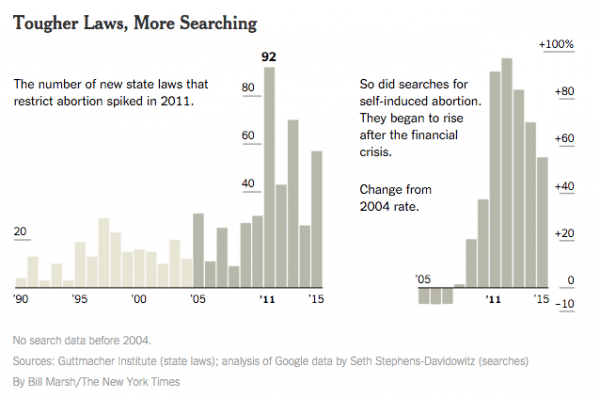
An article in The New York Times recently outlined the disturbing rise in ‘backyard abortions’ following the mass closure of legal abortion clinics in America.
Thousands of women are being forced backwards in history, to a dark and dangerous time of self-abortions. We’re talking knitting needles, coat hangers, and bleached uteruses. Punching themselves in the stomach. Eating bogus concoctions of herbs. Desperately trying to order contraband abortion pills on the black market. Risking imprisonment.
These women – teens, businesswomen, mothers – are being forced to put their own lives in danger in frantic attempts to keep their lives on a path that didn’t, at that very moment in time, involve bringing a child into the world.
Looking closer to home, our situation is less dire – but still far from perfect.
Since a Republican-led push in 2011, almost 200 abortion clinics have shut their doors across the southern states of America. It is staggering to think that across the five states of Mississippi, Missouri, North Dakota, South Dakota and Wyoming, just one single abortion clinic remains.
In The New York Times article ‘The Return Of The D.I.Y. Abortion’, author Seth Stephens-Davidowitz correlates a rise in home-abortion online searches, with the new abortion bans.
He quickly states the obvious: there are no official records of how many women are getting abortions in America. Clearly, it is a highly personal experience and one most would be hesitant to share.

Top Comments
Says a lot about the home of the brave and the land of the free that women have to resort to such desperate measures
The criminalization of abortions will increase infantacide, child abuse, child abandonment etc and I don't know how these lawmakers can justify that. Pregnancy happens sometimes when women don't want it to, and they should have the right to choose. Simple.
You say it's simple, and yet a vast amount of people disagree with you.
Doesn't sound so simple.
How can they justify that? - In their view they are saving a life.
But what sort of "life" awaits the child of an unwanted pregnancy? What sort of adverse impact will an unwanted child have on the life of the mother?
It leads to a better life than being aborted does.
I guess religious people (like myself) would say that all life is sacred and it's not for a person to say whether someone else's life has value or is worth living